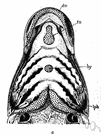Second
branchial arch lineages of the middle ear of wild type and Hoxa2 mutant mice.
The most widely accepted theory is that cysts occur due to entrapment of ectodermal tissue in midline in third or fourth week of embryonic development, from the first or second
branchial arch, therefore the term congenital cyst was accepted.
Ikeda proposed that auricle-based dermoid cysts occurred during the fusion of first
branchial arch because all the five cases in Japanese literature were placed in the superior pole.
The MxP of the first
branchial arch and the MNP converge and fuse to form the lips on the 38th day of gestation.[20] Thus, NSCL is the result of the abnormal fusion of the MNP and MxP during the facial developmental process.
The etiology of pharyngoceles often has been associated with elevations in intrapharyngeal pressure, as seen in individuals who play wind instruments; however, it has been postulated that pharyngoceles also can be a manifestation of a
branchial arch anomaly, specifically a branchial sinus outpouching that may dilate over time.
First and second
branchial arch syndromes: multimodality approach.
Differential diagnoses include hemifacial microsomia (first and second
branchial arch syndrome) and its variant such as Goldenhar syndrome, but these are congenital and essentially non-progressive conditions.
Branchial arch anomalies are the second most common congenital abnormality, representing 17% of congenital anomalies in the head and neck region in the pediatric population [1].
Embryologically, the normal right subclavian artery originates from the right fourth
branchial arch. An aberrant right subclavian artery with or without a Kommerell's diverticulum is the most common arch anomaly of the aorta.
Sakamoto (1984) utilized data on the branchial apparatus in his phylogenetic studies of Pleuronectidae, exploiting seven characters: 5th ceratobranchials, the shape of the 1st epibranchial, teeth on the 3rd epibranchial, gill rakers on the upper limb of the
branchial arch, spines on gill rakers, shape of gill rakers and bony plates on the
branchial arches.
Grabb, "The first and second
branchial arch syndrome," Plastic and Reconstructive Surgery, vol.
 branchial arch - one of the bony or cartilaginous arches on each side of the pharynx that support the gills of fishes and aquatic amphibians
branchial arch - one of the bony or cartilaginous arches on each side of the pharynx that support the gills of fishes and aquatic amphibians